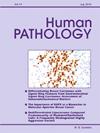细胞周期蛋白 D1 阴性套细胞淋巴瘤
IF 2.7
2区 医学
Q2 PATHOLOGY
引用次数: 0
摘要
细胞周期蛋白 D1 阴性套细胞淋巴瘤(MCL)被认为是一种 B 细胞肿瘤,其形态学和免疫表型结果与典型的 MCL 无异。通过免疫组化和 t(11;14)(q13;q32)/IGH::CCND1,这些肿瘤缺乏细胞周期蛋白 D1 的过表达。自 2003 年首次通过基因表达谱分析发现细胞周期蛋白 D1 阴性 MCL 以来,关于这一实体的诊断一直存在混乱,主要原因是大多数临床实验室缺乏识别这些肿瘤的诊断工具。积累的数据显示,大多数细胞周期蛋白 D1 阴性的 MCL 病例都存在 CCND2 或 CCND3 易位,并伴有多种基因伙伴。在本综述中,我们按时间顺序讨论了细胞周期蛋白 D1 阴性 MCL 的概念,以加深我们对这一实体的理解。然后,我们讨论了目前可用的诊断方法,最后提出了未来的发展方向。我们还建议,对于已知重排基因的肿瘤,应使用更具体的术语 CCND2 重排 MCL 或 CCND3 重排 MCL,而对于重排基因未知的肿瘤,则保留 cyclin D1 阴性 MCL 这一术语。本文章由计算机程序翻译,如有差异,请以英文原文为准。
Cyclin D1-negative mantle cell lymphoma
Cyclin D1-negative mantle cell lymphoma (MCL) is regarded as a B-cell neoplasm that has morphologic and immunophenotypic findings indistinguishable from typical MCL. These neoplasms lack cyclin D1 overexpression by immunohistochemistry and t(11;14)(q13;q32)/IGH::CCND1. Since cyclin D1-negative MCL was first recognized by gene expression profiling in 2003, there has been diagnostic confusion regarding this entity, mostly attributable to a lack of diagnostic tools to recognize these neoplasms in most clinical laboratories. Accumulated data show that most cyclin D1-negative MCL cases harbor CCND2 or CCND3 translocation with a variety of gene partners. In this review, the concept of cyclin D1-negative MCL is discussed in chronological order to further our understanding of this entity. We then discuss currently available diagnostic approaches and we conclude with future directions. We also suggest that the more specific terms CCND2-rearranged MCL or CCND3-rearranged MCL be used for neoplasms in which the rearranged gene is known, and that we reserve the term cyclin D1-negative MCL for neoplasms in which the rearranged gene in unknown.
求助全文
通过发布文献求助,成功后即可免费获取论文全文。
去求助
来源期刊

Human pathology
医学-病理学
CiteScore
5.30
自引率
6.10%
发文量
206
审稿时长
21 days
期刊介绍:
Human Pathology is designed to bring information of clinicopathologic significance to human disease to the laboratory and clinical physician. It presents information drawn from morphologic and clinical laboratory studies with direct relevance to the understanding of human diseases. Papers published concern morphologic and clinicopathologic observations, reviews of diseases, analyses of problems in pathology, significant collections of case material and advances in concepts or techniques of value in the analysis and diagnosis of disease. Theoretical and experimental pathology and molecular biology pertinent to human disease are included. This critical journal is well illustrated with exceptional reproductions of photomicrographs and microscopic anatomy.
 求助内容:
求助内容: 应助结果提醒方式:
应助结果提醒方式:


